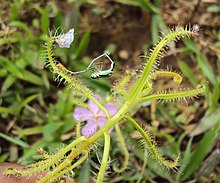| Drosera indica | |
|---|---|

| |
| D. indica in Narsapur, Medak district, India | |
| Conservation status | |
 Least Concern (IUCN 3.1) | |
| Scientific classification | |
| Kingdom: | Plantae |
| Clade: | Tracheophytes |
| Clade: | Angiosperms |
| Clade: | Eudicots |
| Order: | Caryophyllales |
| Family: | Droseraceae |
| Genus: | Drosera |
| Subgenus: | Drosera subg. Drosera |
| Section: | Drosera sect. Arachnopus |
| Species: | D. indica |
| Binomial name | |
| Drosera indica L. | |

Drosera indica, sometimes known as the Indian sundew, is a species of sundew native to tropical and southern Africa, Madagascar and tropical and subtropical Asia. It was first described by Carl Linnaeus in his Species Plantarum in 1753. Until the early 21st century it was mostly considered a highly variable species with a wide distribution including Australia, but since 2000 several distinct species have been separated from D. indica within Drosera section Arachnopus, which is often referred to as the ‘Drosera indica complex’. Many of these species are endemic to Australia, but D. indica itself is now widely considered to be absent from that country.
Description
Drosera indica is an unbranched, annual herbaceous plant, supported by a fibrous root system and reaching a height of 5–50 cm (2–20 in). Leaves are narrowly linear, up to 10 cm long with 1–1.5 cm pedicels. Young plants stand upright, while older ones form scrambling stems with only the newest growth exhibiting an upright habit. The plant can be yellow-green to maroon in color. Flower petals can be white, pink, orange, or purple. Its chromosome count is 2n=28.
References
- ^ Lansdown, R.V. (2018). "Drosera indica". The IUCN Red List of Threatened Species. 2018 (e.T168864A19632217). doi:10.2305/IUCN.UK.2018-2.RLTS.T168864A19632217.en. Retrieved 30 October 2024.
- "Drosera indica L." Plants of the World Online. Royal Botanic Gardens, Kew. Retrieved 30 October 2024.
- "Drosera indica". International Plant Names Index (IPNI). Royal Botanic Gardens, Kew; Harvard University Herbaria & Libraries; Australian National Botanic Gardens. Retrieved 30 October 2024.
- Susandarini, Ratna; Collins, Graham G.; Lowrie, Allen; Conran, John G. (2002). "Morphological variation within the Drosera indica (Droseraceae) complex in northern Australia" (PDF). Australian Journal of Botany. 50: 207–214. Retrieved 30 October 2024.
- Lowrie, Allen; Nunn, Richard; Robinson, Alastair; Bourke, Greg; McPherson, Stewart; Fleischmann, Andreas (2017). Drosera of the World Vol. 1. Poole, Dorset, England: Redfern Natural History Productions. ISBN 978-1-908787-16-3.
- ^ Lowrie, Alan. 1998. Carnivorous Plants of Australia, volume 3. University of Western Australia Press. p. 180.
- Kondo, K. 1969. Chromosome numbers of carnivorous plants. Bulletin of the Torrey Botanical Club, 96(3): 322–328.
External links

![]() Media related to Drosera indica at Wikimedia Commons
Media related to Drosera indica at Wikimedia Commons
This Droseraceae article is a stub. You can help Misplaced Pages by expanding it. |